
IRICA Disputes Fiscal 2020-21 Caviar Export Statistics
EghtesadOnline: Iran’s caviar exports stood at 2.28 tons worth $1.09 million in the fiscal 2020-21 (ended March 21, 2021), says Rouhollah Latifi, spokesman of the Islamic Republic of Iran's Customs Administration, adding that the figures provided recently by an Agriculture Ministry official were inaccurate.
“Of the 12 tons of caviar produced in Iran in the year ending March 2021, 4.5 tons worth more than $6 million were exported,” Isa Golshahi, an official with Iran Fisheries Organization, was quoted as saying by IRNA recently.
“In addition, 3,500 tons of sturgeon meat were produced in Iran last year, of which 1,000 tons worth $10 million were exported.”
Latifi noted that the main destinations for Iranian caviar were the UAE with 560 kilograms, Germany with 220 kg, Japan with 202 kg, Belgium with 201 kg and Spain with 199 kg of caviar, Mehr News Agency reported.
Russia with 175 kilograms, Britain with 163 kg, the Netherlands with 125 kg, Hong Kong with 67 kg, Kuwait with 49 kg, Taiwan with 46 kg, Singapore with 45 kg, Australia with 34 kg, Oman with 33 kg, Italy with 31 kg, Venezuela with 30 kg, Switzerland with 28 kg, Qatar with 26 kg, Canada with 20 kg, Thailand with 13 kg, South Korea with 6 kg, Nigeria with 5 kg, Cambodia with 3 kg and Sweden with 1 kg of caviar exports were other destinations.
Caviar exports to 23 countries worldwide hit 1.27 tons worth $539,490 in the first half of the current fiscal year (March 21-Sept. 22).
The UAE with 410 kg, Britain with 213 kg, Portugal with 82 kg, Kuwait with 77 kg and Japan with 76 kg of caviar were the main caviar export destinations in H1.
Caspian Sea, in northern Iran, is the world’s primary and largest habitat of the beluga, the most famous sturgeon species, as well as four other sturgeon species.
However, the deteriorating condition of Caspian Sea has long been threatening the fish with extinction. The declining sturgeon population and the ban on their fishing have caused a downtrend in Iran’s caviar exports.
Studies show that most of the world’s sturgeon spawn in the rivers flowing into the Caspian Sea. Iran has some of the harshest laws on poaching the fish while authorities have sought to persuade other countries in the region to implement similar regulations to protect the fish.
The long, prehistoric fish, whose glittery, bead-like eggs make the choicest caviar, had been driven nearly to extinction by overfishing.
Now, dozens of Iranian producers are raising sturgeons legally on fish farms.
“In their latest meeting, the Caspian littoral states have decided to extend the ban on fishing sturgeons for commercial purposes until the end of 2021. The decision was made to protect the rare Caspian aquatic creature. We hope to see the ban extended for years to come,” Golshahi said.
The ban has been in place since 2011.



